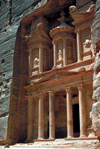Rock has always been the preferred building material of the ancient nobility and the priesthood. As long as you had plenty of cheap labour, a good supply of rock and a fair deal of mathematical and engineering expertise, building with stone was the only way to make sure your monument outlasted your own mortality.
All the great ancient buildings are made of stone. The Egyptian Pyramids were made with sedimentary limestone, igneous granite and maybe even capped with gold. Stonehenge was constructed with hard igneous basalt and sedimentary sarsen sandstone. The Taj Mahal in India is made of brilliant white metamorphic marble and the Moi statues of Easter Island from igneous volcanic tuff rock.
Some have withstood the ravages of time much better than others, but all were built to last with strength, beauty and grandeur.
This topic investigates the properties and uses of the more common rocks used for building: granite, basalt, sandstone, slate, limestone, marble, mica and chalk.
Granite
Granite is a beautiful and hard igneous rock capable of being cut and
polished to a high mirror finish. It is usually used for facing or finishing
off rather than as a construction stone. Granite is traditionally the
stone chosen by both architects and engineers when permanence, enduring
colour and texture, as well as freedom from deterioration and maintenance
are the prime requirements. Many modern city buildings use granite for
its beauty and ability to withstand chemical attack from pollution. Granite
is also found in kitchens, where it is used for chopping blocks and bench
tops because of its durability and chemical resistance.
Basalt
 Basalt
rock is very plentiful, making up most of the igneous rock on or near
the surface of the Earth. In Victoria, basalt is sometimes referred to
as 'Bluestone'. It is very hard and resists moisture and chemical attack.
Used mainly in foundations or as road base, basalt was used in the construction
of the inner circle of Stonehenge over 5 000 years ago in the U.K. and
some of the more substantial buildings of the 19th century
England and Australia. Many of Melbourne's major churches, cathedrals
and older schools have been built with basalt.
Basalt
rock is very plentiful, making up most of the igneous rock on or near
the surface of the Earth. In Victoria, basalt is sometimes referred to
as 'Bluestone'. It is very hard and resists moisture and chemical attack.
Used mainly in foundations or as road base, basalt was used in the construction
of the inner circle of Stonehenge over 5 000 years ago in the U.K. and
some of the more substantial buildings of the 19th century
England and Australia. Many of Melbourne's major churches, cathedrals
and older schools have been built with basalt.
Sandstone
 Also
at Stonehenge, is a stone arrangement consisting of a horseshoe of tall
uprights of sarsen sandstone encircled by a ring of tall sarsen uprights,
all originally capped by horizontal sarsen lintels. The very large sandstone
rocks were selected for their ability to be carved and shaped as well
as for their durability. Many houses use sandstone in paving and wall
construction, because it is easy to cut and prepare. Over long periods
of time sandstone will wear, especially in steps and paving, but it is
relatively cheap to replace.
Also
at Stonehenge, is a stone arrangement consisting of a horseshoe of tall
uprights of sarsen sandstone encircled by a ring of tall sarsen uprights,
all originally capped by horizontal sarsen lintels. The very large sandstone
rocks were selected for their ability to be carved and shaped as well
as for their durability. Many houses use sandstone in paving and wall
construction, because it is easy to cut and prepare. Over long periods
of time sandstone will wear, especially in steps and paving, but it is
relatively cheap to replace.
Sandstone, being a sedimentary rock, is typically much softer than igneous rock, making it easier to work with and to cut precisely. Sandstone's colour is determined by its composition. Iron oxides create red sandstone, and other minerals produce white, yellow, or grey sandstone.
Slate
 Slate
is a hard metamorphic rock that is easily split into layers and cut. Used
mainly in roofing of older houses, inside flooring and the bases of pool
tables, slate is used for its durability. Usually dark grey, slate can
vary in shade and colour.
Slate
is a hard metamorphic rock that is easily split into layers and cut. Used
mainly in roofing of older houses, inside flooring and the bases of pool
tables, slate is used for its durability. Usually dark grey, slate can
vary in shade and colour.
Limestone
Limestone is a white sedimentary rock formed from particles of shells
and bone from marine animals. The blocks of the Great Pyramid of Cheops
in Giza, Egypt are made of limestone. High quality limestone can be cut
and polished appearing like marble from a distance. The surface of the
Cheops pyramid was once covered in polished limestone, much of which was
removed to build the mosques and buildings of old Cairo.
Limestone is relatively easy to work with, but suffers badly from corrosion
and chemical weathering. In the present dry climate of Egypt, this is
less of a problem, although some degradation has occurred in the pyramids
due to rising acidic ground water. In the polluted cities with acid rain,
the calcium carbonate in the limestone reacts with the acid in the rain
and soon dissolves the rock away.
Marble
 Marble
is the metamorphic rock formed from limestone. Usually a brilliant white,
marble is prized for its ability to retain a high polish and its workability.
Michelangelo's David is carved from a block of marble as are many Greek
and Roman statues. Marble has traditionally been used for high quality
finishes, flooring and staircases in the grandest buildings.
Marble
is the metamorphic rock formed from limestone. Usually a brilliant white,
marble is prized for its ability to retain a high polish and its workability.
Michelangelo's David is carved from a block of marble as are many Greek
and Roman statues. Marble has traditionally been used for high quality
finishes, flooring and staircases in the grandest buildings.
Hard-wearing and easily worked, marble's only downfall is its origin.
Like limestone, marble is composed of calcium carbonate, so it is also
badly affected by modern city pollution and acid rain.
Mica
Mica is a delicately layered metamorphic mineral which is slightly transparent.
Because mica is highly heat resistant, in the past mica has been used
in furnaces and fire place windows where normal glass would melt. Mica
speckle is also used in paving, giving the glitter that makes steps and
paths stand out as well as in nail polish glitter, make-up and lip sticks.
Chalk
 Chalk,
as used in schools, is a very soft sedimentary rock formed from seashells.
Like limestone and marble, it is composed of calcium carbonate.
Chalk,
as used in schools, is a very soft sedimentary rock formed from seashells.
Like limestone and marble, it is composed of calcium carbonate.
Summary
From the grandest and the oldest structures to everyday use, rocks have
been and will always be an important building material.
| Copyright owned by the State of Victoria (Department of Education and Early Childhood Development). Used with Permission. |





